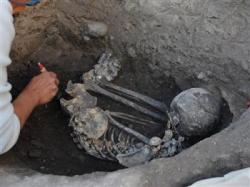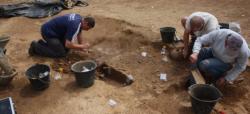INSTITUT SUPERIEUR D'ANTHROPOLOGIE
INSTITUTE OF ANTHROPOLOGY
ONLINE COURSES / COURS A DISTANCE
NEW OPEN COURSE : JANUARY 2013
HRM 104 : INTRODUCTION TO INTANGIBLE CULTURAL HERITAGE
REGISTER NOW
ISRAËL –  Jezreel Valley - Archaeologists have uncovered a well dating back to the Neolithic period some 8,500 years ago, Israel's Antiquities Authority said on Thursday, adding that two skeletal remains were found inside.The well, discovered in the Jezreel Valley in the northern Galilee region, contained a variety of artifacts, as well as the remains of a woman approximately 19 years old, and an older man, the IAA said. Archaeologists said it was unclear how the pair came to be in the well, but hailed the discovery of the ancient water source. "Wells from this period are unique finds in the archaeology of Israel and probably also in the prehistoric world in general," said Omri Barzilai, head of the authority's prehistory branch. He said one other well of a similar age had already been discovered in Israel. "The exposure of these wells makes an important contribution to the study of man's culture and economy in a period when pottery vessels and metallic objects had still not yet been invented," he added. Yotam Tepper, excavation director for the IAA, said numerous artifacts were recovered from inside the well, including sickle blades and arrow heads. "The impressive well that was revealed was connected to an ancient farming settlement," he said. Tepper added that the well demonstrated "the impressive quarrying ability of the site's ancient inhabitants and the extensive knowledge they possessed regarding the local hydrology and geology, which enabled them to quarry the limestone bedrock down to the level of the water table."
Jezreel Valley - Archaeologists have uncovered a well dating back to the Neolithic period some 8,500 years ago, Israel's Antiquities Authority said on Thursday, adding that two skeletal remains were found inside.The well, discovered in the Jezreel Valley in the northern Galilee region, contained a variety of artifacts, as well as the remains of a woman approximately 19 years old, and an older man, the IAA said. Archaeologists said it was unclear how the pair came to be in the well, but hailed the discovery of the ancient water source. "Wells from this period are unique finds in the archaeology of Israel and probably also in the prehistoric world in general," said Omri Barzilai, head of the authority's prehistory branch. He said one other well of a similar age had already been discovered in Israel. "The exposure of these wells makes an important contribution to the study of man's culture and economy in a period when pottery vessels and metallic objects had still not yet been invented," he added. Yotam Tepper, excavation director for the IAA, said numerous artifacts were recovered from inside the well, including sickle blades and arrow heads. "The impressive well that was revealed was connected to an ancient farming settlement," he said. Tepper added that the well demonstrated "the impressive quarrying ability of the site's ancient inhabitants and the extensive knowledge they possessed regarding the local hydrology and geology, which enabled them to quarry the limestone bedrock down to the level of the water table."
http://www.hurriyetdailynews.com/israel-dig-uncovers-8500-year-old-well.aspx?pageID=238&nID=34230&NewsCatID=375
FRANCE –  Verson - Les fouilles archéologiques préventives effectuées au cours du printemps et de l’été 2012 sur le chantier du futur écoquartier de Verson n’était que la partie émergée de l’iceberg. Depuis la fin juillet, un autre travail tout aussi pointilleux a pris le relais. Après cette première étape de fouilles, chacun des "mobiliers" – les objets retrouvés sur place – est soigneusement lavé et fiché. Dès janvier prochain, l’heure sera venue d’examiner de manière plus poussée les éléments découverts. Ils ne manquent pas : sur cet espace d’un peu moins de deux hectares, les archéologues ont mis au jour une nécropole gauloise d’une centaine de tombes, et un ensemble de maisons datant du néolithique, aux alentours de 5 000 avant J-C. "On savait ce que l’on cherchait depuis le diagnostic réalisé par l’Institut national de recherches archéologiques préventives en 2010. Mais nous nous ne attendions pas à trouver dans les restes de ce village autant de mobiliers, dont certains ont été conservés de manière exceptionnelle. Bracelets en schiste, silex et porcelaine... même les graines recueillies vont nous aider à mieux comprendre comment ils vivaient, et quel était le paysage qui les entourait. Cela va bouleverser ce que l’on sait de cette période dans le quart nord-ouest de la France", relève Cécile Germain, l’archéologue en charge du chantier. 70 caisses d’objets divers ont ainsi été collectées. :La nécropole, aux découvertes moins exceptionnelles, a aussi permis de révéler plusieurs grandes chambres funéraires autour desquelles les tombes ont été creusées pendant plusieurs siècles. Les trouvailles inédites de ce chantier seront passées à la loupe dès janvier 2013. Un rapport devrait être finalement rendu d’ici juin 2014.
Verson - Les fouilles archéologiques préventives effectuées au cours du printemps et de l’été 2012 sur le chantier du futur écoquartier de Verson n’était que la partie émergée de l’iceberg. Depuis la fin juillet, un autre travail tout aussi pointilleux a pris le relais. Après cette première étape de fouilles, chacun des "mobiliers" – les objets retrouvés sur place – est soigneusement lavé et fiché. Dès janvier prochain, l’heure sera venue d’examiner de manière plus poussée les éléments découverts. Ils ne manquent pas : sur cet espace d’un peu moins de deux hectares, les archéologues ont mis au jour une nécropole gauloise d’une centaine de tombes, et un ensemble de maisons datant du néolithique, aux alentours de 5 000 avant J-C. "On savait ce que l’on cherchait depuis le diagnostic réalisé par l’Institut national de recherches archéologiques préventives en 2010. Mais nous nous ne attendions pas à trouver dans les restes de ce village autant de mobiliers, dont certains ont été conservés de manière exceptionnelle. Bracelets en schiste, silex et porcelaine... même les graines recueillies vont nous aider à mieux comprendre comment ils vivaient, et quel était le paysage qui les entourait. Cela va bouleverser ce que l’on sait de cette période dans le quart nord-ouest de la France", relève Cécile Germain, l’archéologue en charge du chantier. 70 caisses d’objets divers ont ainsi été collectées. :La nécropole, aux découvertes moins exceptionnelles, a aussi permis de révéler plusieurs grandes chambres funéraires autour desquelles les tombes ont été creusées pendant plusieurs siècles. Les trouvailles inédites de ce chantier seront passées à la loupe dès janvier 2013. Un rapport devrait être finalement rendu d’ici juin 2014.
http://www.tendanceouest.com/caen/actualite-43475-verson-va-reveler-etendue-de-ses-tresors-archeologiques.html?version=rouen
ROYAUME UNI – 
 Hayle - The national significance of two of Hayle's most important archaeological sites has been recognised after a battle lasting a decade. The sites, which span more than 2,000 years of history, are now on the official list of scheduled monuments in England. The oldest site, between Carnsew Road and Plantation Lane, includes an Iron Age hill-fort, an early Christian memorial stone and 19th-century landscaped paths. The other is the 18th- to 19th-century mill complex, ropeworks and associated water management system east of Millpond Avenue, Foundry.
Hayle - The national significance of two of Hayle's most important archaeological sites has been recognised after a battle lasting a decade. The sites, which span more than 2,000 years of history, are now on the official list of scheduled monuments in England. The oldest site, between Carnsew Road and Plantation Lane, includes an Iron Age hill-fort, an early Christian memorial stone and 19th-century landscaped paths. The other is the 18th- to 19th-century mill complex, ropeworks and associated water management system east of Millpond Avenue, Foundry.
http://www.thisiscornwall.co.uk/Town-archaeology-given-national-status/story-17266406-detail/story.html